If we thought the Turkmenistan side of the border procedures were difficult, we had seen nothing compared with the Iranian side.
My headscarf kept slipping and I had great difficulty carrying my bags and keeping the wretched scarf attached as we stumbled in the overwhelmingly hot and windy conditions from the bus to the Iranian border formalities building. On our breathless arrival we were herded into a waiting room where our passports were immediately confiscated. We waited and waited. Even though we had experienced a number of border crossings in our previous travels, the sitting and waiting during this crossing seemed to go on forever. All we were aware of was that we had no passports and could not communicate with the border staff. Even finding our baggage was difficult.
Out of the blue an official in a white laboratory coat emerged from a room dubiously labelled "The Health Surveillance Camp", called out Alan's name and beckoned him in. After some twenty minutes, I was beginning to worry as Alan had been quite sick the day before. At last Alan emerged looking slightly surprised.The official was in fact a doctor who grilled him about what country he was from and where he had been, then grilled him about his health. Only one other person from about 30 or so of the bus passengers was called in to the Health Surveillance Camp. A strange way to monitor health problems, we thought.
We waited again. One by one the other travellers' names were called to receive their stamped passports. In a now empty room, we were still waiting. Finally we were summoned by a stern faced official. He looked at our passports for some ten minutes, looked at us, then at our passports. Surely, it would not take all that time to ascertain that we were the passport holders? And then to my surprise, he came within inches of my face and just stared at me for what seemed like forever. If it was not such a serious occasion the absurd eye balling would have been laughable. But I didn't laugh.
The whole process took over two hours and it was with a deal of relief that we clutched our passports with sweaty hands and made our way to the exit door and into real Iran. A friendly, smiling face met us. It was Mohammad our guide who immediately handed us cans of icy cold Rani brand peach juice. Hot and bothered, I cannot tell you how much we enjoyed that drink. It was delicious. Accompanied by our driver Hussein, we made our way to the car. "My name is Hussein, but not SADDAM HUSSEIN! Ha, Ha!" laughed our driver. "OK team, let's GO, GO, GO!" he yelled at the top of his voice. Strange, we thought. This guy was sounding like an American. We later found out that Hussein was stationed in the USA for some years whilst he was serving in the army. This was our introduction to some of the more bizarre contradictions we were to experience in Iran.
It was not a great start to our travels in Iran. You cannot help but feel tense when you are so out of control and without your passport. And so far our Iran travels had been difficult to organise, despite the assistance of our travel agent Ms Pari Nikzad of Paritour travel agency. It was almost impossible to book in Australia any flights into or from Iran so we had to book on-line our outgoing flight from Tehran to Dubai. This was a very near disaster as just a few days before we were due to leave for Dubai, we found out that Iran does not recognise e-tickets. And then, to our dismay, Australia (like the USA and several European countries) placed an embargo on all monetary transfers between Australia and Iran just before we were due to leave on our trip. As Iran does not accept any form of credit card and we certainly did not want to travel carrying literally several thousands of Euros with us, paying for our tour became extremely difficult. Thankfully there were some rather creative means around the situation but we did have to carry a lot of cash with us.
The border town on the Iranian side is known confusingly as Sarakhs (Saraghs is on the Turkmenistan side). It was once an important staging post along the famous Silk Road and where our guide Mohammad lived as a child. He had not been back for some 50 years, he told us. We did not stop in Sarakhs. And now that we were finally in Iran our spirits rose as we sped along the very good Iranian roads toward the holy city of Mashad. Shortly after we left Sarakhs we crossed the bare mountain range of the Koppeh Dagh then proceeded through rather non-descript and monotonous desert, stopping on our way to visit Sharaf Rubat.
Constructed in AD 1128, this ancient but well preserved caravanserai - or actually rubat - was a once significant resting place for weary travellers on this old Silk Road route. Mohammad emphasised that there were three distinct types of settlements for travellers. Caravanserais provided accommodation and a meeting place for business to take place, as well as a low level of security for travellers. Castles built in the mountains housed nobles and the military, and obviously provided defence. And rubats were a mixture of the two.
The splendid Sharaf Rubat comprises two courtyards. One housed the military and the other nobles and kings. Underground waterways once provided all the water for the settlement and the surrounding land was farmed to enable it to be a fully self sufficient entity. The logistics of providing its own inhabitants with food and water, let alone the travellers was mind boggling. The rubat lies smack in the middle of a desert environment with no surrounding villages or dwellings. In this delicious solitude, it was easy to let our imagination wander freely and to absorb the great atmosphere and history of this remarkable building. It was one of the few sites we had visited that gave us a really good appreciation of what a rubat or caravanserai actually looked like and how it once functioned as a critical staging post along the Silk Road routes.
During the 185 km trip from Sarakhs to Mashad, Mohammad kept us entertained with interesting and useful information about Iran. He delighted in telling little homilys and was a mine of curious Iranian rhymes and stories. Trained as a chemist, Mohammad had spent most of his career as a university lecturer and later as a school teacher. Now semi-retired, he works part-time as an English interpreter and as a tour guide. Neat in appearance, with a somewhat scholastic manner and always a slight smile, Mohammad tried his utmost on our tour to make our journey enjoyable and interesting. He provided us with an invaluable insight into the complex but fascinating history of the country and an introduction to the lifestyles and culture of the Iranian people. Although some of our days were far too long, we could not fault Mohammad's commitment to his work or to us as his clients. "My duty is to ensure your welfare and your security" he would so often say.
Hussein and Mohammad tried in vain to find the entry to the Mohi Rubat we were also scheduled to visit on our way to Mashad. Secretly we thought this was a god send as by this time it was late in the afternoon. Hot and tired, we were looking forward to a shower and rest in our hotel. Or so we thought.
And suddenly we arrived in the city of Mashad, the holiest city in Iran. We had read widely about the famous Holy Shrine of Imam Reza and knew that Mashad was considered one of the most conservative cities in the country. And we were well used to being in Muslim countries and very comfortable with people of the Islamic faith. But for both Alan and myself, our introduction to Mashad was truly confronting. More precisely, for me, the city and its repressive regime struck a raw nerve of fear. Something was very wrong. The streets were foreign and forbidding. The traffic was chaotic. Cloaked women clutched at their black flowing chadors and with bowed heads hurried across and down the the busy roads. I looked to see if I could see any women wearing just head scarfs like me and couldn't find one. Regal religious men in black clothes walked in groups, or strutted upright and slowly. For both of us, the city was totally confronting.
To our dismay, our car turned off the main street and down into the bowels of the dark and enormous car park of the Holy Shrine of Imam Reza. It was very late in the afternoon and quite frankly, the last thing we wanted to do at this time of the day was to visit a site which was as large and famous as the Holy Shrine. After a week's solid travelling we were exhausted and would have much preferred to do the shrine tour the next morning when we would have had time to rest and recover. In hindsight we should have pleaded for mercy and made the visit the following day.
Mohammad had told me that Ms Pari had given me a gift of a "veil" to wear in the Holy Shrine. In the formidable dark car park Hussein chuckled darkly "A woman looks beautiful in her chador. You too will look beautiful". I was beginning to feel uneasy. Just what did I have to wear?
The scene of Mohammad trying to tie on my chador in the bowels of the black car park was, in the beginning, quite funny. A very large and motherly robed woman laughed and came over to assist. And after much wrenching and tying, to my horror I was finally encapsulated in a head hugging hood, fastened with elastic ties over my head scarf which allowed only my eyes to show, and wrapped in a king size bed sheet of a robe. By this time my humour had more than faded. I was tired, hot, uncomfortable and down right furious. "Don't you EVER get me into this situation again!" I remember roaring at Alan. Which was a bit unfair seeing he had nothing to do with the chador. Mohammad looked upset. We proceeded to the Shrine, me through Women in Chadors Entrance, and Alan and Mohammad in the Free to Dress as You Like Men's Entrance.
My chador must have been made for a very tall and large woman. What's more it was white with blue motives which made my stumbling entrance into the grounds of the shrine even more obvious and humiliating. Anonymous, bodiless, black shrouded ghosts glided past while I stumbled and fell over my clothing. It was not a happy scene.
Iman Reza, a direct descendant of the Prophet Mohammed and heir to the Abbasid caliphate and eighth of the Shiite Imans was according to belief, murdered in 818 AD by the Caliph Ma'mun who was threatened by the charismatic Imam. The grief of his murder is still keenly felt to this day with the Holy Shrine of Reza the spiritual centre of Mashad, attracting some 12 million pilgrims each year who pay their respects to the Imam.
The Imam Reza Shrine complex comprises the mausoleum of the Imam Reza with its magnificent golden dome, the beautiful Gohar Shad Mosque built by the remarkable woman Gohar Shad, queen of a mighty empire and wife of Timur's (Tamerlame's) son Shah Rokh, three museums, a library, four seminaries, a cemetery, the Razavi University of Islamic Sciences, a dining hall for pilgrims, vast prayer halls and other mosques. It is enormous.
Despite my poor humour, I did manage to take in the simply awesome scope of the lavish but extraordinarily beautiful Holy Shrine complex and its massive one square kilometer manicured grounds. A lot of the buildings are strictly off limits to non-Muslims but we did glimpse at a distance into the extraordinarily ornate mirrored interior of the Gohar Shad Mosque, the most holy site next to the Shrine of Imam Reza. The courtyard of the mosque is immense and can accommodate up to 120,000 people praying at the same time.
The obvious question for us was who pays for what must be extraordinary overhead costs and for the upkeep of the complex? The answer of course was the government, or rather the Iranian people. A staggering 12,000 people, 8,000 of whom are volunteers, work in the Shrine complex. According to belief, their work will contribute positively to them being looked after by God and thereby assuring them a place in heaven. We could not help but be impressed by their religious commitment.
Security at the Imam Reza Shrine was very tight. This follows the bombing of the complex in 1994 which killed 27 people. All cameras and bags must be left at the gates and all visitors must register at the International Relations Office (hence the photos have been scanned from post cards). It was here that we were met by one of the mullahs who did his utmost to assist us and explain the Shrine complex. A seriously charming man, perhaps in his early forties with a strong smooth American accent asked us if we would like to watch a video about the Islamic religion and the shrine complex. Alan politely declined, explaining that I was not feeling well and we would not be staying long. "Did we need a hospital?" he asked. "We have one right here" he added brightly. For a moment I was actually pleased I was wearing my chador. I knew my face was burning red hot and all I wanted to do was to get out of the place. The mullah then looked at me carefully, then asked Alan "Is it the clothing that is worrying your wife?". Yes it was. He looked almost sympathetic, nodded and handed us two large and extraordinarily heavy bags containing free books and literature about the Shrine and the Islamic religion.
We found this experience quite chilling. Here was a relatively young man, obviously well educated and had lived in the west, who understood perfectly the impact of his religion and its repression of women. Yet, like other mullahs and religious men he was accepting of it and hence the status quo would most likely remain for many decades to come. After all, why would a lot of traditional Iranian men not like a situation where they were the privileged elite? I found the entire experience both confronting and threatening, perhaps more so through the interaction with this dangerously charming man.

 Mashad, Razavi Khorasan, Iran
Mashad, Razavi Khorasan, Iran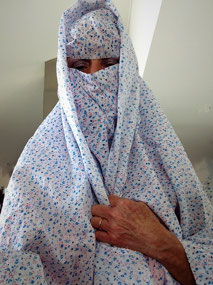







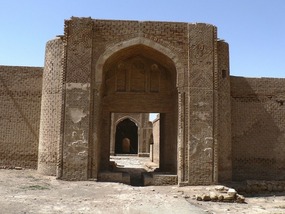
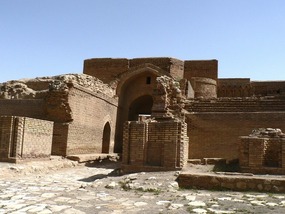
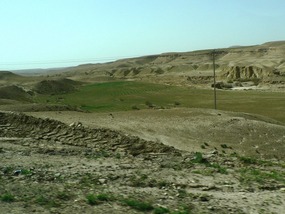
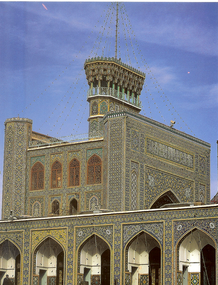
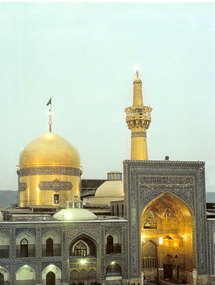
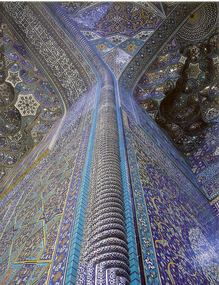
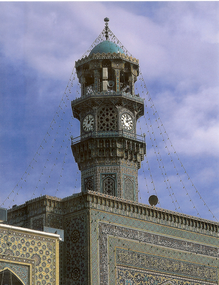
2025-05-23